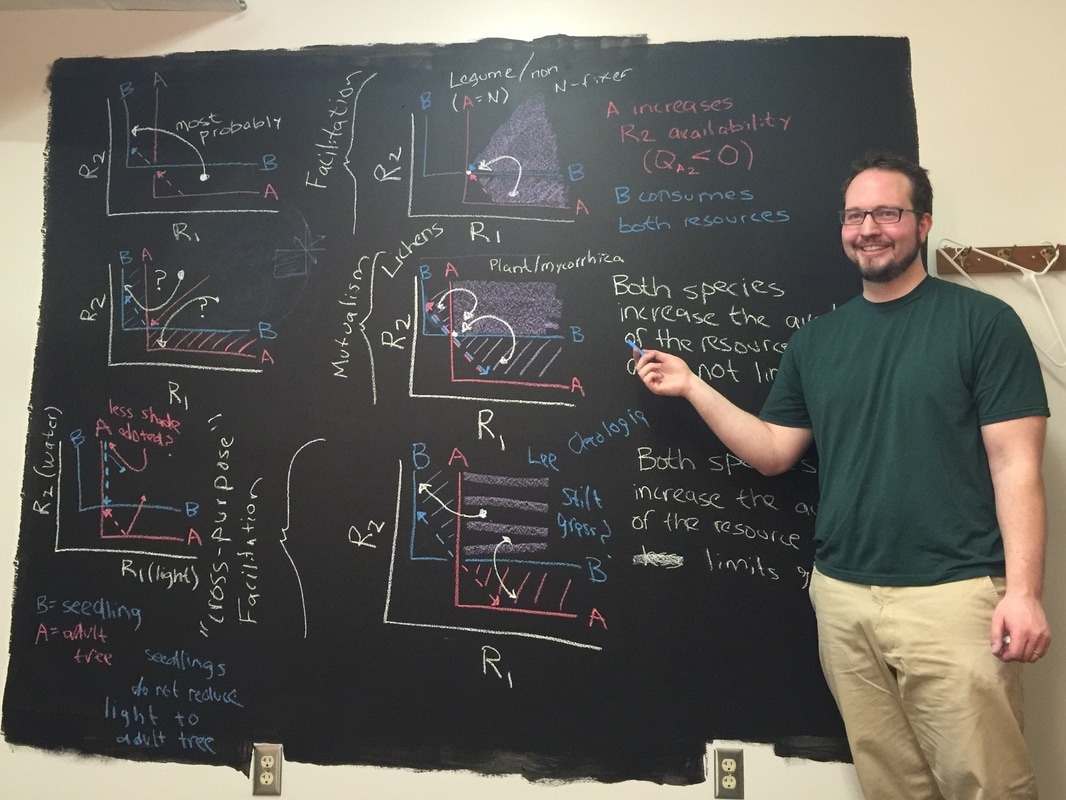
Dr. Brian Steidinger
What’s your research all about (and be free to expand and be philosophical about it)?
I am interested in building an ecology based on simple rules. I embrace physics envy.
Remember intro-physics when you learned the basic equations governing a ball rolled off the end of a desk? Knowing only the height of the ramp (to get the boll rolling) and the height of the desk (to let gravity do its work), you could use tape to mark an “x” on the dirty tile floor. You would then call the teacher over, set the ball up, let it roll off to its destiny, and watch it land directly on the x.
(Or you might have been clever enough to do the experiment a few times and adjust your calculations, and your tape, accordingly).
To the extent that nature allows, I want ecology to be like this. I want to rise above the context-dependency and dizzying complexity of the system on the ground, find the scale at which this maelstrom coalesces into regular patterns, and to predict how those patterns change. I want to tape x’s over the earth and predict the fall of ecosystems and new biomes.
That’s a lot. I take it one step at a time.
Day to day, I do this by using a 50:50 combo of inductive mining of large datasets and deductive building of new ecological theory. Fusing these two approaches together, I hope to show how deterministic assembly rules can be used to make predictions across space and time. In the context of global change, this means predicting ecosystem collapse before it happens, because we have identified the simplest possible expression of the underlying dynamics and codified these into theory.
My favorite system to study so far is the one between plants and mycorrhizal fungi. This system appeals so much because (1) it is everywhere, (2) it is important, and (3) it is paradoxical. Symbiosis is a positive interaction, beneficial to the plant and to the fungi. This means that plants are “punching above their weight”, setting down roots in environments they would otherwise be unable to tolerate. But it also means that these beneficial partnerships, when they are subject to disruptions, can lead to sudden and irreversible collapse.
Okay, okay, but what are you actually working on, Brian?
Lots of things. Right now, I am most excited about the linking together of two major biogeographical patterns – the latitudinal diversity gradient and the latitudinal mycorrhizal gradient. As you move from the poles to the equator, there is a marked increase in both (1) the richness of species and (2) the abundance of mycorrhizal trees. Setting these two patterns side by side, they seem to fit together as sure as the continents once did.
Using a combination of machine learning and ecological theory, I am trying to figure out the extent to which these two patterns are really one.
More to come on that… For more detailed info, check out my personal website.
-
Publications
Steidinger BS, Büntgen U, Stobbe U, Tegel W, Sproll L, Haeni M, Moser B, Bagi I, Bonet JA, Buée M, Dauphin B, Martínez-Peña F, Molinier V, Zweifel R, Egli S & Peters M (2022) The fall of the summer truffle: recurring hot, dry summers drive declining fruit body production of Tuber aesitivum. Global Change Biology early view. ( DOI: 10.1111/gcb.16424 )
Staubli F, Imola L, Dauphin B, Molinier V, Pfister S, Piñuela Y, Schürz L, Sproll L, Steidinger BS, Stobbe U, Tegel W, Büntgen U, Simon E & Martina P (2022) Hidden fairy rings and males—Genetic patterns of natural Burgundy truffle (Tuber aestivum Vittad.) populations reveal new insights into its life cycle. Environmental microbiology early view. ( DOI: 10.1111/1462-2920.16131 )
Braghiere RK, Fisher JB, Fisher RA, Shi M, Steidinger BS, Sulman BN, Soudzilovskaia NA, Yang X, Liang J, Peay KG, Crowther TW & Phillips RP (2021) Mycorrhizal Distributions Impact Global Patterns of Carbon and Nutrient Cycling. Geophysical Research Letters 48:e2021GL094514 ( DOI: 10.1029/2021GL094514 )
Steidinger BS & Peay KG (2021) Optimal Allocation Ratios: A Square Root Relationship between the Ratios of Symbiotic Costs and Benefits. American Naturalist 198 ( DOI: 10.1086/716182 )
Steidinger BS, Bhatnagar JM, Vilgalys R, Taylor JW, Qin C, Zhu K, Bruns TD & Peay KG (2020) Ectomycorrhizal fungal diversity predicted to substantially decline due to climate changes in North American Pinaceae forests. Journal of Biogeography 47:772-782 ( DOI: 10.1111/jbi.13802 )
Steidinger BS, Crowther TW, Liang J, Van Nuland ME, Werner GDA, Riech P, Nabuurs GJ, de-Miguel S, Zhou M, Picard N, Herault B, Zhao X, Zhang C, Routh D, Global Forest Biodiversity Intiative (GFBI) & Peay KG (2019) Climatic controls of decomposition drive the global biogeography of forest tree symbioses. Nature 569 404–408. ( DOI: 10.1038/s41586-019-1128-0 )
Smith GR, Steidinger BS, Bruns TD & Peay KG (2018) Competition-colonization tradeoffs structure fungal diversity. The ISME Journal 12:1758-1767 ( DOI: 10.1038/s41396-018-0086-0 )
Jander CK & Steidinger BS (2017) Why mutualist partners vary in quality: mutation–selection balance and incentives to cheat in the fig tree–fig wasp mutualism. Ecology Letters 20:922-932 ( DOI: 10.1111/ele.12792 )
Steidinger BS & Bever JD (2016) Host discrimination in modular mutualisms: a theoretical framework for meta-populations of mutualists and exploiters. Proceedings of the Royal Society B 283:20152428 ( DOI: 10.1098/rspb.2015.2428 )
Steidinger BS (2015) Qualitative differences in tree species distributions along soil chemical gradients give clues to the mechanisms of specialization: why boron may be the most important soil nutrient at Barro Colorado Island. New Phytologist 206:895-899. ( DOI: 10.1111/nph.13298 )
Steidinger BS, Turner BL, Corrales A & Dalling JW (2015) Variability in potential to exploit different soil organic phosphorus compounds among tropical montane tree species. Functional Ecology 29:121-130 ( DOI: 10.1111/1365-2435.12325 )
Steidinger BS & Bever JD (2014) The coexistence of hosts with different abilities to discriminate against cheater partners: an evolutionary game-theory approach. American Naturalist 183:762-770 ( DOI: 10.1086/675859 )
-
(Update: 14.10.2022 )
